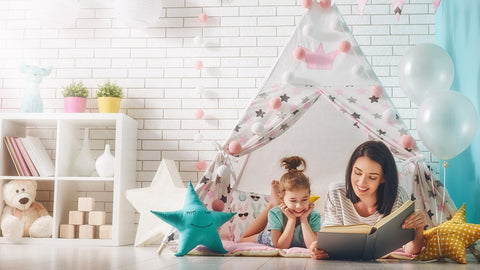Home Literacy Environment Checklist
Posted on February 10 2020
Home Literacy Environment Checklist
See how your home reading environment stacks up with this checklist containing all the essentials for success.
 Learning starts at home, which means that some of your child’s first experiences with reading and writing will happen here. One way to encourage these early learning experiences is by setting up a literacy-friendly environment in your home that encourages your child to explore and thrive. So, what should you have in your home literacy environment? We created the following checklist with tips and ideas in these four categories:
Learning starts at home, which means that some of your child’s first experiences with reading and writing will happen here. One way to encourage these early learning experiences is by setting up a literacy-friendly environment in your home that encourages your child to explore and thrive. So, what should you have in your home literacy environment? We created the following checklist with tips and ideas in these four categories:
• Establishing a reading area
• Literacy materials for your home
• Literacy activities for you and your child
• Literacy behavior to model
Continue reading to learn different ideas and tips for each category of establishing a successful home literacy environment.
Establishing a reading area
Creating a comfortable area for your children to read is an essential part of establishing a home literacy environment. Try these tips to set up reading area that will encourage your children to continually explore books.- Designate a cozy spot
- Set up comfortable seating
- Establish proper lighting
Ensure there is enough natural light, in addition to overhead and task lighting. Good lighting is a vital part of creating a home literacy reading environment that will keep your little reader engaged.
Literacy materials for your home
Once you have your reading area set up, it’s time to focus on substance. You’ll want to have a variety of literacy materials available to your child, so they have plenty to explore.- Books
- Front-facing bookshelves
- Reading tools for kids
- Writing materials
- Labels
Labeling items is another helpful addition to your home literacy environment that can be a fun way to encourage your children to read as they carry out their daily activities. Consider placing labels on toy, food, or clothing bins – it may have your child practicing their reading without even noticing!
Literacy activities for you and your child
Now that you have the designated area and materials needed for a thriving literacy home environment, let’s discuss the different activities you can try together.- Practice the alphabet
- Play word games
- Visit the library
Making regular trips to the library can help establish your child’s love for reading and writing. It’s a great place to pick up new books for your reading environment and participate in other literacy-promoting activities that you can incorporate at home.
Literacy behaviors to model
Children tend to model their behavior after the adults around them, especially their parents. Here are a few literacy-promoting routines to incorporate into your home literacy environment:- Read where your child can see you
- Use a wide vocabulary
Using a robust vocabulary at home can help your child pick up new words. Try using interesting words in everyday conversation, like a tart apple or a mischievous cat.
This checklist containing tips and ideas for establishing your home literacy environment can help your child develop critical and practical reading skills for years to come. Check out our blog to learn more about setting your child up for literary success.


0 comments